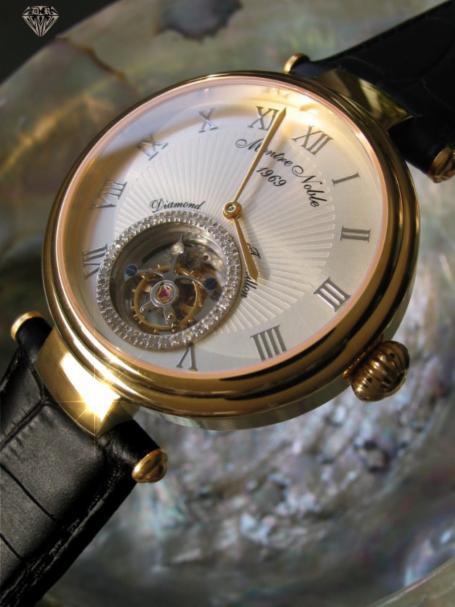
Unsere Tourbillonmodelle: Our Tourbillon models:
________________________________________________
Modell "Bora Bora" Fliegender Minuten Tourbillon, Régulateur, mit 72 Brillanten, Edelstahl roségold vergoldet, handaufzug, handskelettiertes Werk, mit floralem Motiv graviert, Limitierte Auflage weltweit 50 St.,2-fach Saphirglas, Glasboden, wasserdicht, Echtlederarmband mit vergoldeter Faltschließe, Maße: 42 mm ohne Krone, 12 mm hoch, 103 g schwer
Flying minute Tourbillon à Régulateur, with 72 diamonds, stanless steel plated with pink gold, hand winding, skeleton movement engraved with floral motiv, limited edition worldwide 50 pcs., 2x sapphire glass, water resistant, glass bottom, genuine leather strap with plated clasp, measurement: 42 mm diameter (without crown), 12 mm high, 103 g weight
Modell "Tahiti"
Fliegender Minuten Tourbillon Régulateur mit 180 Brillanten auf dem Gehäuse und dem skelettierten Zifferblatt, Edelstahl gelbgold vergoldet, handaufzug, Skelettwerk handgearbeitet mit floraler Gravur, Limitierte Auflage von weltweit 100 St., 2-fach Saphirglas, Glasboden, wasserdicht, echtes Louisiana-Kroko-Band nach Wunschfarbe mit vergoldeter Faltschließe oder Dornschließe,
Maße: 43 mm (ohne Krone), Höhe 13 mm, Gewicht 98 g
Fliegender Minuten Tourbillon Régulateur mit 180 Brillanten auf dem Gehäuse und dem skelettierten Zifferblatt, Edelstahl gelbgold vergoldet, handaufzug, Skelettwerk handgearbeitet mit floraler Gravur, Limitierte Auflage von weltweit 100 St., 2-fach Saphirglas, Glasboden, wasserdicht, echtes Louisiana-Kroko-Band nach Wunschfarbe mit vergoldeter Faltschließe oder Dornschließe,
Maße: 43 mm (ohne Krone), Höhe 13 mm, Gewicht 98 g
Flying minute Tourbillon à Régulateur with 180 real diamonds on the case and dial, stanless steel yellow gold plated, hand winding, skeleton movement with floral engravings, limited edition of worldwide 100 pcs. 2x sapphire glass, glass bottom, waterresistant, genuine louisiana-croco strap in different colors with plated clasp, Measurement: 43 mm (without crown), high 13 mm, weight 98
g
Modell "Image"
Tourbillon Elegance, fliegend gelagertes Tourbillonwerk, Edelstahl vergoldet mit goldenen Ziffern und Zeigern auf blauem Zifferblatt, handaufzug, offener Tourbillonkäfig, Saphirglas, wasserdicht, Echtlederarmband mit vergoldeter Faltschließe, Design-Montre-Noble- Blau mit Varianteneffekt je nach Lichteinfall,
Maße: 42 mm (ohne Krone), Höhe 12 mm, Gewicht 102 g
Tourbillon Elegance, fliegend gelagertes Tourbillonwerk, Edelstahl vergoldet mit goldenen Ziffern und Zeigern auf blauem Zifferblatt, handaufzug, offener Tourbillonkäfig, Saphirglas, wasserdicht, Echtlederarmband mit vergoldeter Faltschließe, Design-Montre-Noble- Blau mit Varianteneffekt je nach Lichteinfall,
Maße: 42 mm (ohne Krone), Höhe 12 mm, Gewicht 102 g
Tourbillon elegance, flying tourbillon movement, stanless steel gold plated with gold hands and numbers onto blue dial, hand winding, open tourbillon case, sapphire glass, waterresistance, genuine leather strap with plated clasp, special Design-Montre-Noble-Blue with effect depending on the light, Measurement: 42 mm (without crown), high 12 mm, weight 102 g
Modell "Moorea d´Or"
Tourbillon mit 36 + 1 Brillanten um den Tourbillonkäfig, Gehäuse Edelstahl gelbgold vergoldet mit eleganten Bandanstößen, römische Ziffern, schwarze Zeiger auf platin-silberfarbenem guillochiertem Zifferblatt, offener Tourbillonkäfig, 2-fach Saphirglas, Limitierte Auflage von weltweit 100 St., wasserdicht, Glasboden, Echtes Louisiana-Krokodil - Lederarmband mit vergoldeter Faltschließe oder Dornschließe, Maße: Durchmesser 42 mm (ohne Krone), 12 mm hoch, 99 g schwer
Tourbillon mit 36 + 1 Brillanten um den Tourbillonkäfig, Gehäuse Edelstahl gelbgold vergoldet mit eleganten Bandanstößen, römische Ziffern, schwarze Zeiger auf platin-silberfarbenem guillochiertem Zifferblatt, offener Tourbillonkäfig, 2-fach Saphirglas, Limitierte Auflage von weltweit 100 St., wasserdicht, Glasboden, Echtes Louisiana-Krokodil - Lederarmband mit vergoldeter Faltschließe oder Dornschließe, Maße: Durchmesser 42 mm (ohne Krone), 12 mm hoch, 99 g schwer
Tourbillon with 36+1 real diamonds round the tourbillon case, case stanless steel yellow gold plated, platinum silver colored guillochiert dial with roman numbers and black hands, open Tourbillon case, 2x sapphire glass, glass bottom, limited edition of worldwide 100 pcs., waterresistant, genuine leather strap with plated clasp, Measurement: diam. 42 mm (without crown), high 12 mm, weight 99 g
Modell: "Moorea Argent" in Stahl
Allgemeines zum Tourbillon:
Eine Konstruktion um Schwerpunktfehler im Schwingsystem dieser Uhr auszugleichen. Das komplette Schwing- u. Hemmungssystem ist in einem leichten Käfig integriert, der sich um die eigene Achse dreht. In der senkrechten Lage einer Uhr können die negativen Einflüsse der Erdanziehung ausgegichen werden und die Gangleistung der Uhr verbessert werden. Die Konstruktion ist sehr aufwendig. Sie wurde 1801 von Abraham Louis Breguet erfunden.
Generals for the Tourbillon:
A construction to compensate defaults in the centre of gravity in the swinging system. The complete swing and impede system is integrated in a small cage, which turns around it´s own axis. In the vertical position of the watch the negative influences of the earth gravity can be compensated and the exact function of the movement could be improved. This construction is very complicated. It was invented 1801 by Abraham Louis Breguet.









